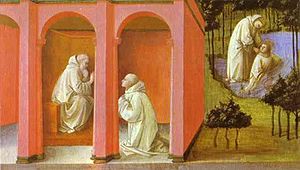Saint Maurus
| Saint Maurus, O.S.B. | |
|---|---|

St. Benedict orders St. Maurus to the rescue of St. Placid
by Friar Filippo Lippi, O.Carm. (ca.1445). |
|
| Born | January 1, 512 Africa |
| Died | January 15, 584 not for sure |
| Feast | after 1969: November 22 |
| Attributes | crutch; weighing scale; young man in the garb of a monk, holding an abbot's cross and a spade. |
| Patronage | cripples; invoked against rheumatism, epilepsy, gout, hoarseness, cold; Azores; charcoal burners; cobblers; coppersmiths; shoemakers |
Saint Maurus, O.S.B. (or Maur), was the first disciple of St. Benedict of Nursia (512-584). He is mentioned in St. Gregory the Great's biography of the latter as the first oblate; offered to the monastery by his noble Roman parents as a young boy to be brought up in the monastic life. Four stories involving Maurus recounted by Gregory formed a pattern for the ideal formation of a Benedictine monk. The most famous of these involved St. Maurus's rescue of Saint Placidus, a younger boy offered to St. Benedict at the same time as St. Maurus. The incident has been reproduced in many medieval and Renaissance paintings.
Saints Maurus and Placidus are venerated together on 5 October.
A long Life of St. Maurus appeared in the late 9th century, supposedly composed by one of St. Maurus's 6th-century contemporaries. According to this account, the bishop of Le Mans, in western France, sent a delegation asking Benedict for a group of monks to travel from Benedict's new abbey of Monte Cassino to establish monastic life in France according to the Rule of St. Benedict. The Life recounts the long journey of St. Maurus and his companions from Italy to France, accompanied by many adventures and miracles as St. Maurus is transformed from the youthful disciple of Benedict into a powerful, miracle-working holy man in his own right. According to this account, after the great pilgrimage to Francia, St. Maurus founded Glanfeuil Abbey as the first Benedictine monastery in Gaul. It was located on the south bank of the Loire river, a few miles east of Angers. The nave of its thirteenth-century church and some vineyards remain today (according to tradition, the chenin grape was first cultivated at this monastery.)
Scholars now believe that this Life of Maurus is a forgery by the late-9th-century abbot of Glanfeuil, Odo. It was composed, as were many such saints' lives in Carolingian France, to popularize local saints' cults. The bones of St. Maurus were 'discovered' at Glanfeuil by one of Abbot Odo's immediate predecessors, Abbot Gauzlin, in 845. Gauzlin likely invented or at least strongly promoted the cult of Benedict's disciple, taking advantage of Glanfeuil's proximity to two famous and prosperous Benedictine culture centers of the Loire region: the cult of St. Benedict's bones at Fleury and that of St. Scholastica's relics at Le Mans.
...
Wikipedia
